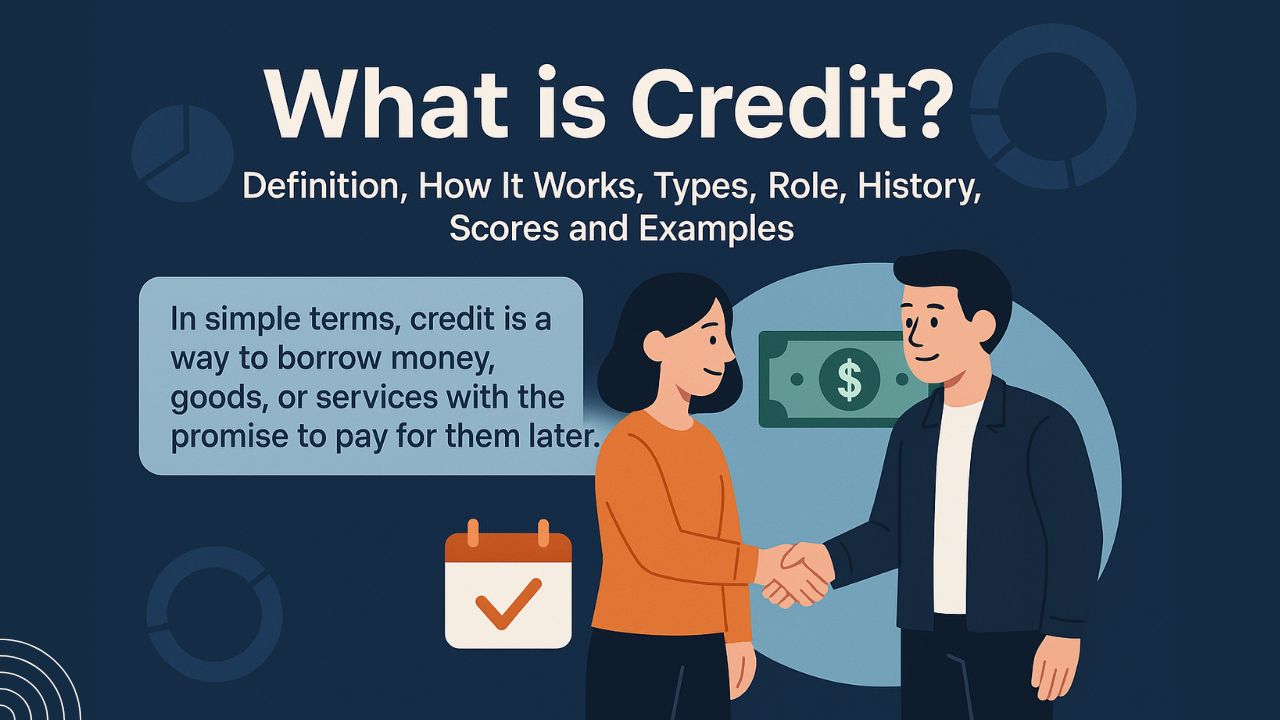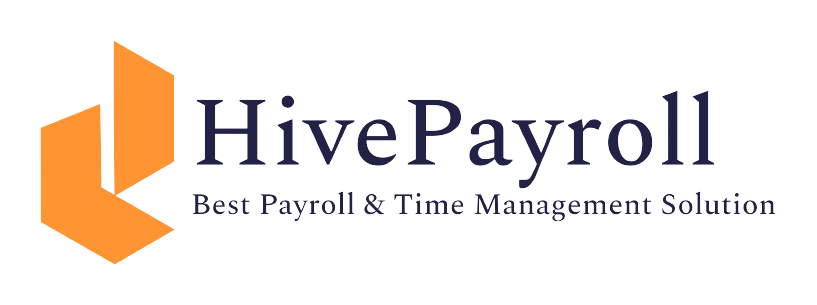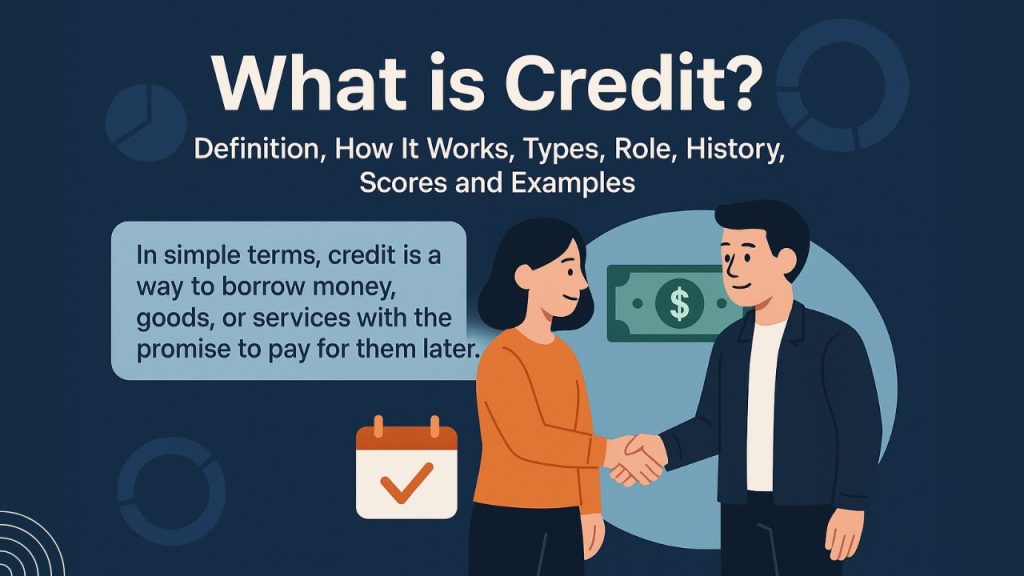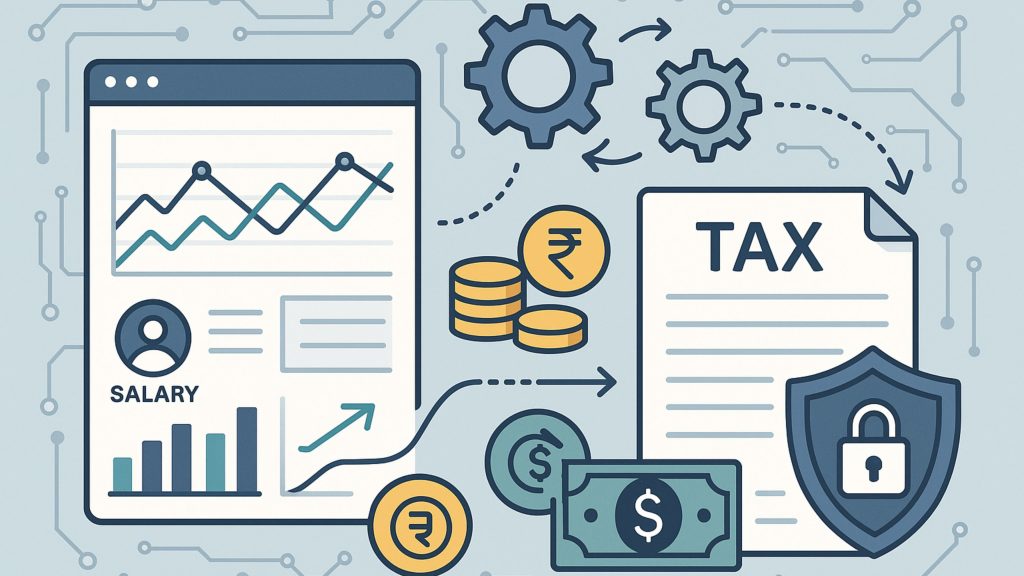What is Credit? Definition, How It Works, Types, Role, History, Scores and Examples

Credit plays a central role in our financial lives, shaping how we buy, borrow, invest, and plan for the future. Whether it’s purchasing a car, paying for education, managing daily expenses with a credit card, or expanding a business, credit allows us to use money today with the promise of repayment tomorrow. But credit is more than just a convenience — it is a system built on trust, responsibility, and financial discipline. Understanding how credit works, the different forms it can take, and how our credit behavior influences our credit history and score is essential for making informed financial decisions. This guide breaks down the concept of credit in clear and practical terms so you can not only understand it, but use it wisely to build a strong financial foundation.
What is Credit?
Credit is the ability to obtain goods, services or cash now with a promise to pay later — usually with interest or fees. In practice it’s any arrangement where a lender trusts a borrower to repay money in the future.
Why credit matters
- For individuals: credit makes large purchases (home, car, education) possible, smooths cash flow for emergencies, and helps build a financial reputation (credit score) that affects future borrowing costs.
- For businesses & the economy: credit enables business investment and growth, which supports jobs and wider economic activity. Lenders’ willingness to extend credit is a core part of how modern economies function.
How credit actually works – step-by-step
- Application / approval: a lender (bank, NBFC, card issuer) assesses your ability to repay using income, existing debts, and credit history. Approval may involve setting a credit limit and interest rate.
- Access & use: once approved you access funds (loan disbursed) or borrowing capacity (credit card, line of credit).
- Repayment obligation: you must repay principal + interest (and any fees) according to the product terms (monthly instalments, minimum card payments, etc.).
- Reporting & scoring: lenders report account activity to credit bureaus; this becomes part of your credit history and drives your credit score, which affects future loan approvals and pricing.
Main types of credit (with simple examples)
Credit generally falls into two broad categories: revolving and installment — plus a few other forms.
A. Revolving credit
- What: Borrow up to a limit, repay (fully or partially), and borrow again.
- Examples: credit cards, some lines of credit (e.g., personal line of credit).
- How you pay: minimum monthly payments or full balance; interest accrues on carried balances.
- Teaching example: credit card with ₹50,000 limit — you spend ₹20,000, pay ₹5,000 one month and carry ₹15,000 to next month; interest applies on the carried amount.
B. Instalment credit
- What: Borrow a fixed sum and repay in fixed instalments over a set term.
- Examples: mortgages, auto loans, student loans, personal installment loans.
- Teaching example: ₹3,00,000 car loan at fixed EMI for 5 years — monthly EMI includes principal + interest.
C. Secured vs Unsecured
- Secured credit: backed by collateral (home, car). Lower interest is common because lender can repossess collateral on default.
- Unsecured credit: no collateral — higher interest because the lender takes more risk (many credit cards, personal loans).
D. Charge cards
- What: require full balance payment each billing period (no revolved balance allowed). Often useful for controlled spending / business expense flows.
E. Other forms (letters of credit, trade credit)
- Used a lot in business finance and trade (e.g., supplier extends payment terms; bank issues a letter of credit to guarantee payment).
Credit history and credit scores – what they are & why they matter
Credit history (the record)
A credit report is a record of how you’ve used credit: accounts, balances, payment history, defaults, enquiries, bankruptcies. Lenders and bureaus compile it.
Credit score (a summary number)
A credit score is a numeric summary of credit risk derived from the history. In many scoring systems higher = lower risk. Lenders use it to set interest rates, loan size and approval.
Typical score factors (what counts most)
- Payment history (timely payments = most important).
- Credit utilization (how much of available credit you use — lower is better).
- Length of credit history (older accounts help).
- Types of credit (mix of instalment and revolving).
- New credit / enquiries (many recent applications can lower score).
Score ranges & “what’s good”
Score scales vary by model (e.g., FICO in US uses 300–850). Generally, scores above the high-600s/700s are considered good, but exact bands depend on the country and scoring model. Lenders each have their own thresholds.
Simple numeric examples of credit
Example A — Installment loan math (conceptual)
Loan: ₹2,00,000 at 8% annual interest, 3-year term. Monthly EMI formula calculates fixed payment that repays principal + interest over 36 months. (Use EMI calculators in class to show amortization: early payments are mostly interest; later payments reduce principal.)
Example B — Revolving credit and utilization
Card limit ₹1,00,000. Balance ₹40,000 → utilization 40% (higher utilization can hurt score). Paying down to ₹10,000 reduces utilization to 10% and often improves score over time.
Example C — How missed payment affects score
A single missed payment reported late can lower score significantly, especially if it becomes 30/60/90 days past due. Repeated or severe delinquencies (collections, charge-offs) harm future borrowing ability.
Recommended Reads for You
Advantages and risks of credit (teaching points)
Advantages
Access to large purchases, emergency funds, smoother cash flows, rewards/cashback (cards), ability to build credit history for better loan terms.
Risks
High interest, overspending, debt spiral if minimum payments accumulate, damage to credit score from missed payments or overuse. Lenders can repossess collateral for secured loans.
How to build and protect credit
- Make payments on time — the single most important habit.
- Keep credit utilization low — aim under ~30% (lower is better).
- Keep older accounts open (unless they cost you heavily) to preserve history.
- Avoid many hard inquiries in a short time.
- Use a mix of credit responsibly (installment + revolving) to show you manage different account types.
- Monitor your credit report regularly and dispute errors promptly. Many countries allow free annual credit reports or tools from bureaus.
- Protect against fraud — place alerts or freezes if identity theft is suspected.
Credit – Short glossary
- Principal: the original amount borrowed.
- Interest: cost of borrowing, expressed as a rate.
- EMI: equated monthly instalment (fixed monthly payment on an instalment loan).
- Credit limit: maximum you may borrow on a revolving account.
- Credit utilization: balance ÷ limit (expressed as a percentage).
- Hard inquiry / soft inquiry: hard = lender checks your file (may affect score); soft = info check or personal check (no effect).
Conclusion
Credit is a powerful financial tool — and like any tool, its impact depends on how we use it. When managed responsibly, credit helps us access opportunities, save on interest costs, and build a strong financial reputation that supports long-term goals. However, careless borrowing, missed payments, and high debt levels can quickly lead to financial stress and limit future financial flexibility. The key is to approach credit with awareness: understand the terms, borrow within your means, pay on time, and maintain healthy credit habits. By doing so, you not only maintain a good credit score, but also build confidence and control over your financial life. Ultimately, learning how credit works is not just about borrowing money — it’s about shaping your financial future with clarity and intention.
Frequently Asked Questions (FAQs)
A credit score is a three-digit number (usually ranging from 300 to 900) that summarizes your creditworthiness or the likelihood you will repay borrowed debt. It is important because lenders use it to decide whether to approve your loan or credit card application, and to determine your interest rate and credit limit. A higher score typically results in better terms and lower interest rates.
A credit report is a detailed history of your credit accounts, payment history, and inquiries. A credit score is a numerical value calculated from the data within your credit report.
No, checking your own credit score is considered a "soft inquiry" and does not negatively impact your score. It is a healthy financial practice to monitor your report regularly for accuracy.
The most significant factors are your payment history (paying bills on time), which accounts for the largest portion (around 35%) of your score, and your credit utilization ratio (how much of your available credit you are using), which accounts for about 30%.
Key ways to improve your score include making all payments on time, keeping your credit card balances low (ideally below 30% of your limit), maintaining a long credit history, and only applying for new credit when necessary.
While a low credit score can make loan approval more complex and lead to higher interest rates, it doesn't mean it is impossible. Some lenders may offer options, but you should be aware of potentially less favorable terms or fees. You can also build credit with a secured credit card or by finding a co-signer.
A secured loan requires you to provide collateral (an asset like a house or car) that the lender can take if you default on payments. An unsecured loan (like a credit card or personal loan) does not require collateral, but typically has higher interest rates to offset the increased risk for the lender.
No, using a debit card does not help build your credit score. Debit card transactions use money already in your bank account and are not reported to credit bureaus, as no borrowing is involved.
Generally, no. Closing an old account can actually lower your score by reducing your total available credit (increasing your credit utilization ratio) and shortening the length of your credit history, which are both negative factors.
Most negative information, such as late payments or accounts sent to collections, generally remains on your credit report for up to seven years from the date of the first missed payment.









